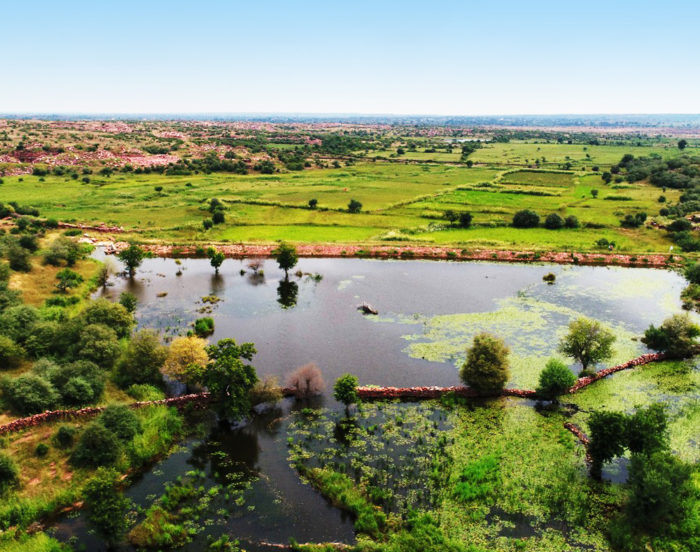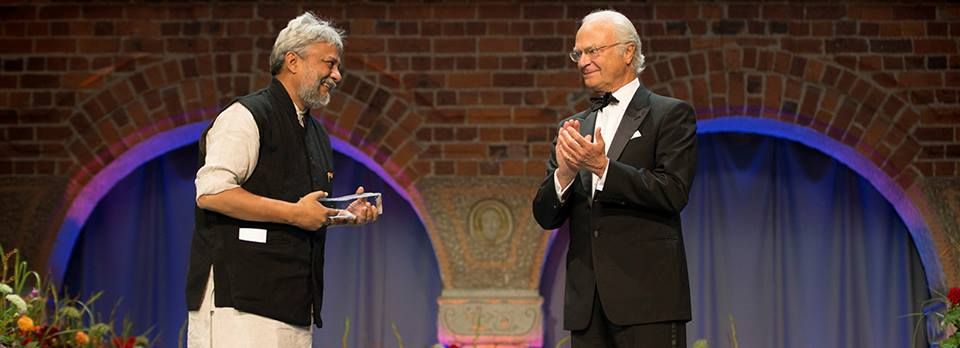M. A. Siraj
“The migration of labour to work centres in far off cities is water-induced. People would stay back in villages if the water is perennially available for farming,” says Rajinder Singh, the ‘waterman of India’ and the winner of the Magsaysay Award in 2001 and Stockholm Water Prize in 2015.
At a time when the nation is grappling with the issue of sending back lakhs of labourers to their hometowns mainly in north Indian and North-eastern states, water-conservationist Rajinder Singh’s advice carries meaning. He was speaking at a webinar on ‘Traditional Water Management Systems” coordinated from Bengaluru by Dr. Neelam Manjunath, Chairman of the Centre for Green Building Materials and Technologies (CGBMT) on Saturday (July 4).

An Ayurvedic doctor by training, Rajinder Singh comes from Baghpat district of Uttar Pradesh but has been ensconced at Bhikhampur village near the Sariska Tiger Reserve in Alwar district of Rajasthan for close to three decades. Singh has been instrumental in rejuvenating five rivers that had been lying dead—Arvari, Ruparel, Jahajwali, Sarsa and Bhagini—running through Aravali region of Rajasthan. Nearly forty years of work by his NGO Tarun Bharat Sangha (TBS) has revived 11,800 water bodies (mainly Johads) spread over 10,600 kms of area.
Tenfold rise
Singh says the water-stressed area in India has grown tenfold since the nation became independent. Now 72% of India faces water crisis and over a hundred districts face floods. Though climate change has contributed to rainfall, the crisis is largely man-made due to over extraction of groundwater leading to drying up of ground aquifers. “Climate change is a global problem, but the solution is local. People should go for decentralized water management and see that ground aquifers are constantly recharged and local water bodies are rejuvenated through community effort,” he remarked.
Water security
Singh says the solution to water crisis does not lie in profit and economic network, but replacing with a water-security objective. “Greed is the real virus, not the Corona that has brought the current devastation. The economy is today guided by profit motive, concentration of wealth, ruthless urbanization, congestion and resultant pollution and pandemic. The planners are chasing GDP, big dams, megabucks projects which ignore the grassroots solutions,” he laments.
Though he was active as a student since 1974 even while doing his course in Ayurvedic medicine, Singh left his job in Jaipur and learnt the traditional water management from an old farmer Mangu Lal Meena in Aravallis from where the farmers were migrating to the cities for work. Meena trained him into working with hands and desilting of the johads and building earthen check dams on the hilly slopes to catch rain runoff prior to monsoons which will recharge the barren land. Meena told him the land was green for centuries but borewells—each deeper than the other—began to extract more water than the rains could replenish. When fields became barren, the youth began to migrate to the cities to look for menial and manual jobs, adults took to drinking and sale of liquor.
Reversing the barrenness
Recounting his experience on his visit to Gopalpura, a village in Alwar district, in 1979, Singh says, he found the village inhabited only by old folk with youth having migrated to cities. There was (ratundhi) night-blindness among a large section of old folks and the women singing “Badal to aate hain har saal par baraste nahin, mere bête aur bahuen mujhse rooth gaye hain”. The Groundwater Board had declared it ‘dark zone’. He says greenery covered only 2% of the area, but today 48% of the area has turned green as the rivers have been rejuvenated and johads have been desilted. He says torrid summers in desert areas of Rajasthan cause massive evaporation, therefore solution lies in storing rainwater, allowing it to seep under the ground and thus keeping the ground water sources charged. He says, johads are convex water bodies with a central depression which harnesses the rainwater. These were traditional water bodies in Rajasthan and Haryana and adjoining parts of Madhya Pradesh.
Discharge vs recharge
Singh says subsurface water is the reserved hydrological currency on which people can fall back upon when surface water dries up. “There is a relationship between discharge and recharge of groundwater and the former should not exceed the later. Unfortunately, ground aquifers are being exploited ruthlessly across the country, hence the crisis and migration. Once we rejuvenated rivers, the ground aquifers in the surrounding areas got charged and migrations stopped. Now village youths grow vegetables and supply it to Azadpur Mandi in Delhi,” he observes.
Coke driven out
He however warns against people taking up water-intensive crops such as sugarcane and onion in areas that have been brought under watershed development. He says when water became available, some farmers began to put water-intensive crops and the Tarun Bharat Sangha had to run campaign against this tendency. Even Coca Cola company was in negotiations for setting up a plant. “We drove them out of the area. Agri-business is enemy of environment and is motivated by profit,” he commented. He opposes the laying of plastic sheets beneath the water in ponds and dubs it a variant of agri-business.
It was in 1986 that Singh started his work on reviving the Arvari river with the help of village volunteers of Tarun Bharat Sangha. It created 375 check dams in its catchment area with the largest being 244-metre long and 7-metre high in the Aravalli Hills. In 1990 the river started flowing and in 1995, it became a perennial river. In 1992, they brought about popular pressure to get the Union Government to put a ban on quarrying and mining in Aravalli Hills. In March 2000, the ‘International River Prize’ was conferred on the Sangha and the villagers. In 2015, he was conferred the Stockholm Prize for his work on rejuvenating the rivers and reversing the eco-degradation. Singh has conducted padyatra along Yamuna, Godavari and Krishna rivers. His campaign in Mumbai reminded the denizens of the city that Mithi was and should be a river, not a nullah as they had begun to call it due to heavy discharge of effluents.

Equal Access
When asked about access to water bodies being restricted to certain sections in the caste-dominated rural areas, Singh says caste and casteism are social phenomena and one cannot wish them away. He, however, said that the Tarun Bharat Sangha from the day one procured signatures from all villagers on a paper which would clearly say “Is Paani par sab ka Adhikar Hoga” (Everyone would have the right to access this water.).
M.A. Siraj is a senior journalist based in Bengaluru

